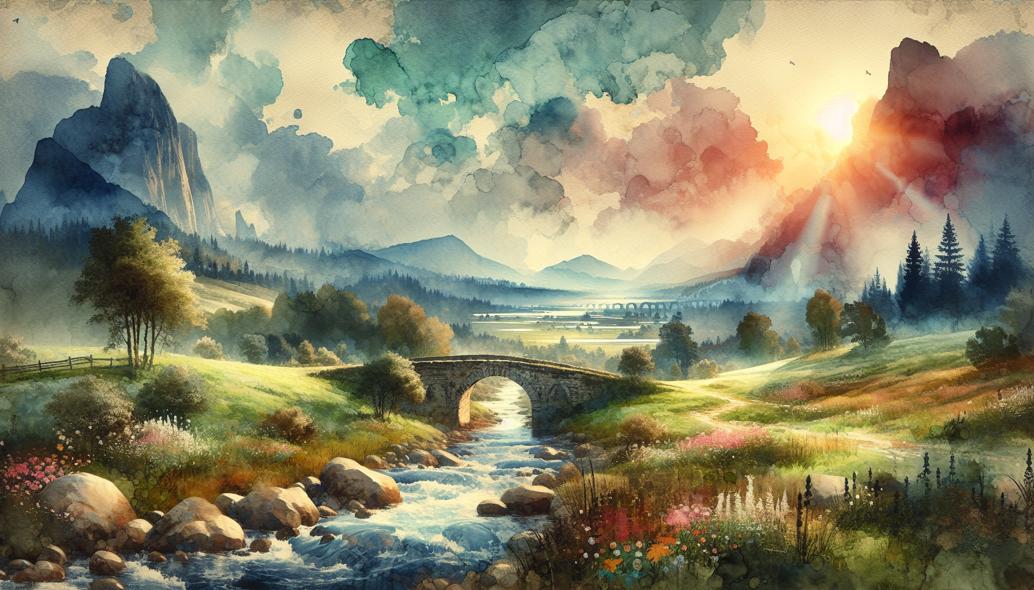Creating Atmospheric Effects in Watercolor Landscapes
Unlock the secrets to creating breathtaking watercolor landscapes! Discover how to master atmospheric effects that capture the magic of light and mood, transforming your art into ethereal vistas.

Crafting Ethereal Vistas: Mastering Atmospheric Effects in Watercolor Landscapes
Creating an atmosphere in art is a nuanced and rewarding endeavor, especially in landscape painting. For those artists who love the fluid beauty of watercolor, learning how to imbue a scene with mood and presence is essential to elevating your artwork. In this blog post, we'll explore advanced watercolor techniques designed to help you create breathtaking atmospheric watercolor effects in your landscape paintings. We'll delve into the magic of light, color, and texture, providing professional landscape painting tips to empower your creative journey.
Understanding the Atmosphere in Art
The atmosphere in art extends beyond mere depiction; it invites viewers into another world, an intimate experience of mood and emotion. In landscape painting, atmosphere connects the various elements of the scene, affecting everything from color temperature to the depiction of light. Mastering these effects in watercolor—a medium known for its translucency and unpredictability—presents unique challenges and opportunities.
Before diving into technical applications, it's important to spend time observing natural settings. Pay attention to how light diffuses through mist or how distant objects like mountains and trees appear softer and cooler in color compared to objects in the foreground. This consciousness of natural atmospheres will inform your approach in watercolor.
Essential Watercolor Techniques for Atmospheric Effects
To achieve atmospheric watercolor effects, begin with a clear understanding of essential watercolor techniques and how they can be applied to landscape painting:
- Wet-on-Wet: This technique, where wet paint is applied to a wet surface, is perfect for creating soft transitions between colors—ideal for skies, mist, and distant horizons. The unpredictability can yield beautiful blends and gradients that mimic natural lighting.
- Glazing: Layering translucent washes of color allows the buildup of depth and subtlety. This technique is useful when transitioning from the delicate morning light to the stark shadows of evening.
- Lifting: Utilizing a dry brush or tissue, lifting involves removing color from wet areas of your painting. It can be used to create highlights, mist, or other light effects like sun-dappled water.
- Gradients and Blending: Mastering gradients and the blending of colors can help create a seamless blend in skies or rolling landscapes.
Advanced Techniques for Landscape Painting
Beyond the basics, integrating advanced techniques in your artwork will significantly augment the realism and mood of your landscapes:
Creating Depth with Color and Value
Understanding and applying color theory are vital. Atmospheric perspective—a principle where distant objects are lighter and cooler than those in the foreground—can be emulated through color value manipulation. Cool colors recede, while warm colors advance. Utilize this knowledge by ensuring your background is composed of lighter, cooler tones to simulate distance.
Capturing Light and Shadow
Light is a crucial component of atmosphere. Observing how natural light interacts dynamically in different weather conditions can inform your painting approach. For example, a sunny landscape might have hard-edged shadows and vibrant colors, while an overcast day calls for diffused light and softened edges. To accentuate chiaroscuro techniques, a good balance of light and shadow will add drama and form to your landscapes.
Influences of Weather and Time
When painting landscapes, the weather and time of day can dramatically alter the atmosphere. For morning fog, use gentle wet-on-wet applications of blues and grays; at sunset, richer reds and purples can be glazes or washes applied over dry paint. This allows underlying details to show through subtly, capturing the essence of the transitional ambiance.

Practical Landscape Painting Tips for Killer Composition
The composition is foundational in bringing a landscape to life. Here are expert landscape painting tips to enhance atmospheric effects:
1. Focal Points and Leading Lines
Determine the focal point of your landscape before beginning. This will help guide your composition decisions. Use leading lines—such as a river or path—to draw the viewer's eye through the painting to your focal point.
2. Simplification and Suggestion
One of the most captivating aspects of atmospheric watercolor is its ability to suggest rather than explicitly tell. Simplify forms in the background to ensure they don't detract from the focal point and overall mood. Let certain areas purposefully bleed, allowing imagination to fill in the details.
3. Balancing Detail and Mystery
Implement detail sparingly. Overworking a landscape can cause the viewer to become overwhelmed with information. Instead, balance areas of intricate detail with those that are left more ambiguous, creating intrigue and depth that invites exploration.
Harmonizing Emotion and Technical Skill
The creation of atmosphere in watercolor landscapes requires equal parts technical skill and emotional intuition. Allow your artistic intuition to guide your choices in color and composition. Sometimes, breaking conventional rules to follow emotion will result in the most profound atmospheric results. Practice relentless patience as you learn to control the capricious nature of watercolor, leveraging it to your benefit in creating ethereal, expressive landscapes.
The Embracement of Watercolor's Unique Qualities
Finally, the key to mastering atmospheric effects in watercolor landscapes lies in embracing the medium's inherent characteristics—its fluidity, transparency, and luminosity. Each brushstroke should be seen as an opportunity to capture a fleeting moment of light and mood.
Watercolor can be an unpredictable but extraordinarily rewarding medium when it comes to capturing atmospheric beauty. With practice, observation, and the thoughtful application of techniques, your landscape paintings will transform into vivid representations of serene natural wonder.
Master these skills, and you will find yourself not just painting landscapes, but inviting viewers to step inside them, offering an enduring experience framed within the delicate beauty of watercolor.
